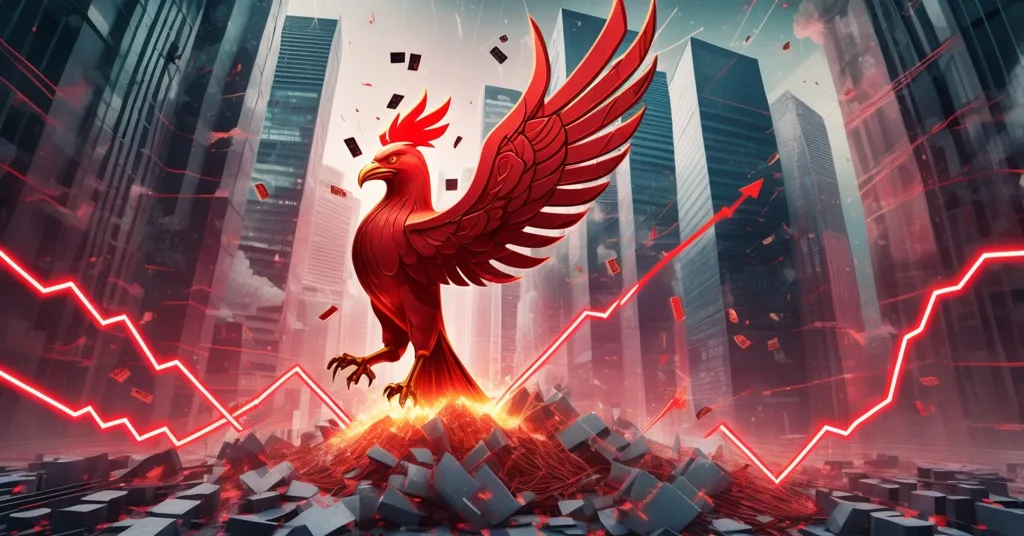Asian Markets Crash: Could Bitcoin Be the Ultimate Safe Haven Hedge?

Asian Markets Tumble Under US Policy Uncertainty: Is Bitcoin the Ultimate Hedge?
Asian stock markets are in a tailspin, rattled by uncertainties over US Federal Reserve rate cuts and the looming threat of President Donald Trump’s tariff deadline on July 9. For Bitcoin and crypto enthusiasts, this chaos in traditional finance isn’t just a headline—it’s a glaring neon sign pointing to the cracks in centralized systems and the potential for decentralized assets to step into the spotlight.
- Market Turmoil: Asian indices like Nikkei 225 (-0.78%), Taiex (-0.31%), and Kospi (-0.87%) are sliding on US policy fears.
- Fiat Fragility: The US dollar hits multi-year lows at 96.649, while gold surges 27% as a safe haven in 2025.
- Crypto Opportunity: Economic instability fuels Bitcoin’s narrative as “digital gold” and bolsters DeFi’s appeal.
Asian Market Meltdown: The Numbers Behind the Panic
The declines across Asian markets are more than just percentage points—they’re a barometer of global investor nerves. Japan’s Nikkei 225, a benchmark for the country’s largest companies, dropped 0.78%, reflecting a sharp pullback in tech stocks mirroring losses in the US after a strong June rally. Taiwan’s tech-heavy Taiex index fell 0.31%, while South Korea’s Kospi took a steeper hit at 0.87%. The broader MSCI Asia-Pacific index outside Japan dipped by 0.23%, signaling a regional unease that’s hard to ignore. These drops aren’t random; they’re tied directly to fears over what the US might do next, both in terms of monetary policy and trade aggression.
For those new to financial markets, stock indices like the Nikkei or Kospi act as snapshots of a country’s economic health, tracking the performance of major companies. When they fall, it often means investors are pulling money out, spooked by uncertainty. Right now, that uncertainty has two big faces: the Federal Reserve’s next move on interest rates and Trump’s tariff brinkmanship. And while traditional investors scramble, the crypto crowd can’t help but see a silver lining in this fiat-driven mess.
US Policy Uncertainty: Rate Cuts and Tariff Threats
Across the Pacific, the US economic landscape is sending mixed signals that keep markets on edge. Job openings in May showed a resilient labor market, a sign of strength, but a crucial payrolls report due Thursday could tilt the scales for the Federal Reserve’s next decision. Markets are currently betting on about 64 basis points of rate cuts in 2025—that’s roughly a 0.64% reduction in interest rates, for those unfamiliar with the term, where a basis point is 1/100th of a percent. Yet, the chance of a cut as early as July sits at a slim 21%, according to market data. Why the hesitation? Federal Reserve Chairman Jerome Powell is playing it safe, wary of inflation spikes that could come from new trade policies.
“Wait and learn more about how tariffs might affect inflation before easing policy.”
Powell’s words, spoken at a recent forum, highlight a central bank caught in a bind. Lowering rates could stimulate the economy but risks fueling inflation if tariffs drive up costs. And with Trump’s July 9 tariff deadline looming—with no extensions on the table—nations like Japan are sweating over failed trade deals, while India shows flickers of hope for an agreement. These trade tensions aren’t just geopolitical drama; they’re market movers, and Asia is feeling the heat most acutely.
Add to this Trump’s political pressure on Powell, publicly slamming him as “terrible” and questioning his competence. This isn’t just noise—it’s a layer of instability that shakes investor trust in US economic leadership. With Powell’s term as Fed Chair ending in 2026 and uncertainty over his future role, the long-term outlook for centralized monetary policy looks murkier than a foggy blockchain transaction.
Fiat’s Fall and Gold’s Rise: A Safe-Haven Rush
While markets wobble, the US dollar is taking a historic beating. The dollar index has slumped to 96.649, its lowest since March 2022, with a 10% drop year-to-date marking its worst first-half performance since the 1970s. The euro is basking in the glow, trading at $1.1799 near a three-and-a-half-year high, while the yen holds steady at $143.52 per dollar. This fiat fragility has investors flocking to traditional safe-haven assets like gold, which has soared 27% in 2025 to around $3,332 per ounce, despite a slight pullback after a recent spike.
Analysts are sounding the alarm on further dollar weakness. Carol Kong from the Commonwealth Bank of Australia put it bluntly:
“Any disappointing economic data can prompt further dovish repricing of FOMC rate cuts and another round of USD selling.”
For clarity, “dovish repricing” means markets expecting the Fed to adopt a softer stance, like cutting rates to boost growth. If that happens, the dollar could sink even lower. Meanwhile, Trump’s proposed tax and spending package, estimated to add a staggering $3.3 trillion to federal debt, isn’t helping. Narrowly passed by the Senate and pending House approval, it’s a fiscal gamble that’s got bond markets oddly calm—US 10-year Treasury yields sit at about 4.25%—but raises serious questions about long-term US debt sustainability. Trillions tossed around like confetti? That’s not a budget; it’s a Bitcoin HODLer’s fantasy setup.
Bitcoin as Digital Gold: Opportunity or Overhype?
This brings us to the heart of why this matters to the crypto community. With the dollar crumbling and gold gleaming as the old-school safe haven, Bitcoin’s narrative as “digital gold” gains serious traction. For newcomers, Bitcoin is often dubbed “digital gold” because, much like the shiny metal, it’s seen as a store of value outside government control, immune to inflation driven by reckless printing presses. When fiat currencies wobble—like the dollar’s 10% drop this year—BTC’s appeal as a hedge against devaluation grows louder.
History backs this up. Post-2020, when the US pumped out stimulus packages and the dollar softened, Bitcoin skyrocketed from $10,000 to over $60,000 in a year as investors sought alternatives. Are we seeing echoes of that now? Possibly. Fiat instability, driven by centralized policy blunders, creates fertile ground for Bitcoin to shine. But let’s not chug the Kool-Aid just yet. Bitcoin isn’t a flawless escape hatch—its price swings can make your stomach drop faster than a bad NFT investment, and regulatory uncertainty, especially with a wildcard like Trump, could slam the brakes on any rally.
As a Bitcoin maximalist at heart, I’ll argue BTC is the purest play against fiat decay, but I can’t ignore that altcoins and other blockchains like Ethereum carve out vital niches. Ethereum’s smart contracts power decentralized finance (DeFi) protocols—think lending or trading without banks—that Bitcoin doesn’t touch. Solana offers dirt-cheap transactions that could appeal in cost-sensitive Asian markets. This ecosystem isn’t a one-trick pony, and pretending Bitcoin solves everything is intellectual laziness.
DeFi’s Role in Economic Chaos: A True Alternative?
Speaking of DeFi, the instability in traditional markets—whether it’s Fed indecision or tariff-fueled volatility—underscores why decentralized systems matter. DeFi operates beyond the reach of bureaucrats and political whims, offering a buffer against the kind of chaos rocking Asian shares. Need a loan or a stable store of value? DeFi platforms on Ethereum let you bypass banks, using stablecoins pegged to assets like the dollar but without the centralized baggage.
Asia, currently bearing the brunt of market declines, is also a hotbed for crypto adoption. South Korea, with its Kospi down 0.87%, boasts a vibrant trading culture—local exchanges like Upbit often outpace global giants in volume. Taiwan, despite Taiex’s dip, is home to blockchain innovation hubs. Economic uncertainty could push retail investors in these regions toward Bitcoin as a protective asset and altcoins as alternative stores of value. If your stock portfolio’s bleeding, why not roll the dice on a decentralized asset? It’s not a wild leap.
The Dark Side of Crypto in Crisis
Before we get too starry-eyed, let’s ground ourselves. Crypto isn’t a guaranteed lifeline. Bitcoin’s volatility is legendary—think of the May 2021 crash, when regulatory fears in China tanked BTC by 30% in days. Regulatory risks loom large, especially with US policies under Trump that could just as easily target crypto as they do foreign trade. And don’t forget scalability hiccups or the energy debates around Bitcoin mining—critics love to harp on its carbon footprint, fair or not.
Then there’s the adoption hurdle. While South Korea and Taiwan are crypto-friendly, broader mainstream uptake in Asia faces cultural and regulatory barriers. Stablecoins might offer entry points for nervous retail investors, but scams and rug pulls in DeFi can scare off newbies faster than you can say “yield farming.” The promise of decentralization is real, but the road is bumpy as hell.
Accelerating Change: Crisis as Crypto’s Catalyst
Here’s where effective accelerationism—our belief in speeding up tech-driven disruption—comes into play. Crises like these, where centralized systems falter under their own weight, are the perfect pressure cooker for crypto to thrive. The more the Fed dithers, the more Trump piles on debt, the faster the world wakes up to alternatives like Bitcoin and DeFi. This isn’t just a market dip; it’s a preview of systemic failure that blockchain tech was built to outmaneuver.
Traditional finance is showing its age—creaky, over-leveraged, and tied to political gamesmanship. Asian markets are bleeding, the dollar’s on life support, and gold can’t scale for a digital age. Crypto, for all its flaws, offers a path forward. The question isn’t if decentralized tech will play a role, but how quickly we can push past the growing pains to make it the norm. If Trump keeps stacking trillions on the debt pile while the Fed plays bureaucratic twiddle-thumbs, that tipping point might hit sooner than anyone expects, especially with the impact of US tariffs on global markets.
Key Questions and Takeaways for Crypto Enthusiasts
- What’s behind the Asian market slump, and why should crypto fans care?
Asian indices are dropping due to uncertainty over US rate cuts and Trump’s July 9 tariff deadline, highlighting fiat instability that could drive interest in Bitcoin as a safe-haven asset. - How does the US dollar’s weakness boost Bitcoin’s case?
With the dollar down 10% year-to-date and at multi-year lows, Bitcoin’s narrative as “digital gold” strengthens as a hedge against fiat devaluation and inflation. - Could Trump’s fiscal policies fuel crypto adoption?
His $3.3 trillion debt-adding package raises alarms about US fiscal health, potentially pushing investors toward decentralized assets like Bitcoin over weakening fiat. - What risks does crypto face amid this economic turmoil?
Bitcoin’s volatility, regulatory threats from US policies, and scalability issues mean it’s no guaranteed safe bet, despite the compelling narrative. - How can DeFi offer stability in centralized market chaos?
DeFi provides alternatives to policy-driven volatility, operating outside government control, which could attract users seeking refuge from traditional financial swings. - Can Asian retail investors leverage crypto during downturns?
In crypto-hot regions like South Korea and Taiwan, retail investors could turn to Bitcoin, stablecoins, and accessible exchanges as hedges against local market declines.



